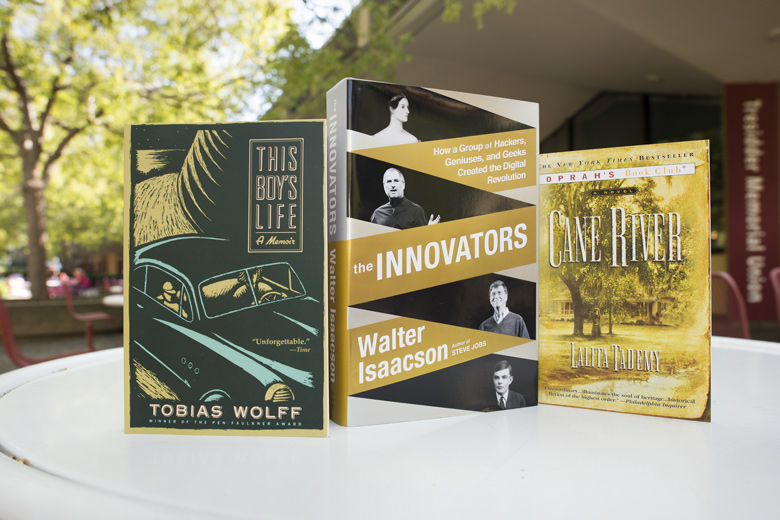Resilience is the theme of Stanford's summer reading program for incoming students
Members of the Class of 2019 are reading books selected by President John Hennessy. The Three Books program serves as an intellectual springboard for freshmen and transfer students.

The annual Three Books program serves as an introduction to intellectual life at Stanford for incoming students. This year’s books were selected by President John Hennessy. (Image credit: L.A. Cicero)
The Class of 2019 received its first college reading assignment from Stanford President John Hennessy, an avid reader who chose three books for them to read over the summer about people who faced challenges and overcame adversity.
He selected This Boy’s Life, a memoir about a 1950s American childhood by Tobias Wolff, a professor of English at Stanford; Cane River, a book of biographical fiction about four generations of African American women in Louisiana by Lalita Tademy; and The Innovators: How a Group of Hackers, Geniuses, and Geeks Created the Digital Revolution by Walter Isaacson.
Hennessy said he chose the books because each one provides invaluable insights about resilience and determination – lessons that will serve students well at Stanford and throughout their lives.
“In This Boy’s Life, Toby has to face and survive a dysfunctional home life, while Cane River relates tales of survival and even personal triumph in the face of slavery and racism,” Hennessy said. “Isaacson’s Innovators focuses on the skills of collaboration, innovation and persistence that are needed to achieve something exceptional.”
This week, Hennessy led an online discussion with new students about The Innovators.
Earlier this month, Adam Johnson, an associate professor of English at Stanford, led an online discussion about This Boy’s Life. (Johnson is the author of The Orphan Master’s Son, which won the Pulitzer Prize for fiction in 2013, and Fortune Smiles, published in 2015.)
On Aug. 26, Michele Elam, a professor of English at Stanford, will lead an online discussion about Cane River. (Elam edited The Cambridge Companion to James Baldwin, published in 2015, and wrote The Souls of Mixed Folk: Race, Politics, and Aesthetics in the New Millennium, published in 2011.)
Each year, under the Three Books program, a Stanford faculty member selects three books for incoming students to read. Stanford mails the books to students living in the United States and around the world.
Hennessy, who is stepping down as president of the university in 2016 after leading the university for more than 15 years, is a professor of electrical engineering and of computer science at Stanford, and the Bing Presidential Professor.
During New Student Orientation, a weeklong program for freshmen and transfer students, Hennessy will moderate a panel discussion with the authors of this year’s selections in Memorial Auditorium.
Stanford has invited members of the faculty and academic staff to watch a simulcast of the panel discussion in nearby Pigott Theater, and to join the students for lunch and further discussion about the books immediately after the program.
Descriptions of the 2015 Three Books program selections follow:
- This Boy’s Life, first published in 1989, introduces readers to the young Toby Wolff, by turns tough and vulnerable, crafty and bumbling, and ultimately winning. Separated by divorce from his father and brother, Toby and his mother are constantly on the move. As Toby fights for identity and self-respect against the unrelenting hostility of a new stepfather, his experiences are at once poignant and comical. The book does a masterful job of re-creating the frustrations and cruelties of adolescence.
- Cane River, published in 2001, is set on a Creole plantation on the banks of Louisiana’s Cane River, where four generations of African American women battle vast injustices to create a legacy of hope and achievement. They are women whose lives begin in slavery, who weather the Civil War, and who grapple with the contradictions of emancipation through the turbulent early years of the 20th century. Through it all, they fight to unite their family and forge success on their own terms.
- The Innovators, published in 2014, tells the story of the people who created the computer and the Internet. What were the talents that allowed certain inventors and entrepreneurs to turn their visionary ideas into disruptive realities? What led to their creative leaps? Why did some succeed and others fail? The book begins with Ada Lovelace, who pioneered computer programming in the 1840s, and explores the fascinating personalities that created the current digital revolution, including Alan Turing, Doug Engelbart, Robert Noyce, Bill Gates, Steve Jobs and Larry Page.
